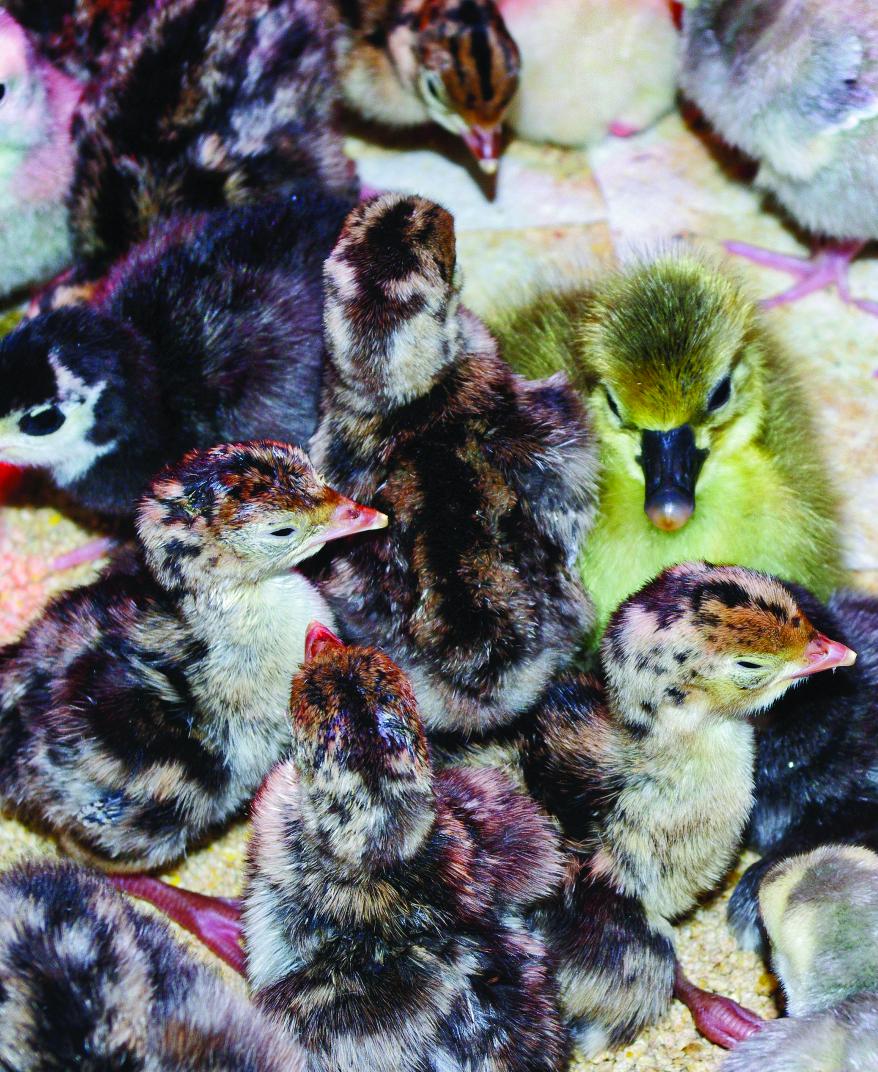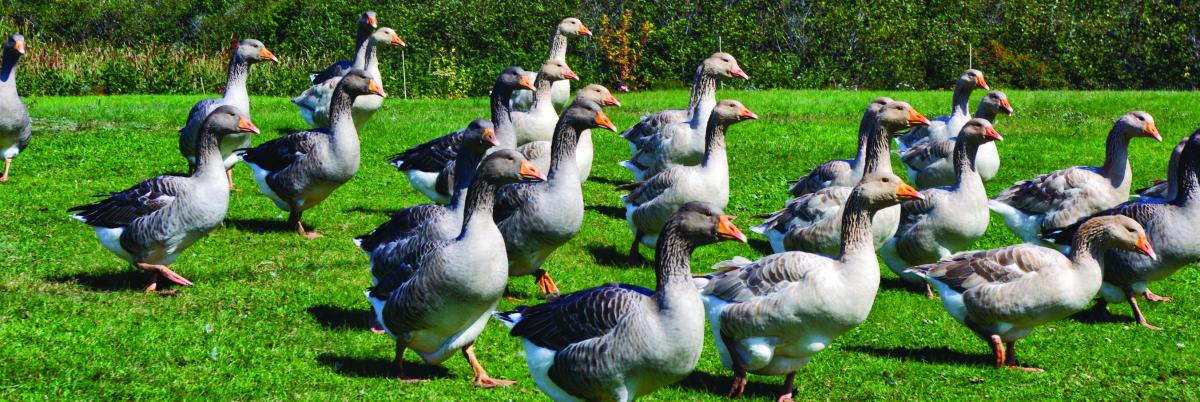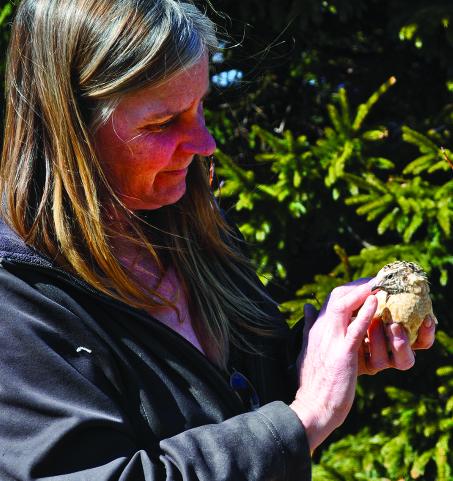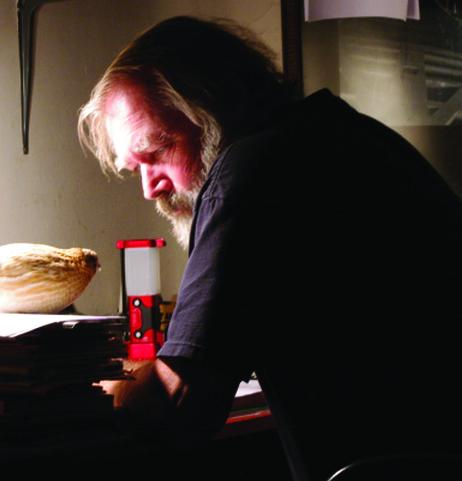 A baby duck hangs out with some baby quail. Photo by Wendy RackliffSoft cheeps merged into one harmonious whisper; the smell of warm sawdust was clean and sweet; and the tiny three-day old quail were Easter-basket cute as they scampered and tumbled in their plastic hatching bin.
A baby duck hangs out with some baby quail. Photo by Wendy RackliffSoft cheeps merged into one harmonious whisper; the smell of warm sawdust was clean and sweet; and the tiny three-day old quail were Easter-basket cute as they scampered and tumbled in their plastic hatching bin.
Dozens of the small multi-colored birds sat on perches or walked over Wendy Rackliff’s feet as we walked into the warm, snug coop. Quail are just one of the many poultry breeds that she raises at Coastal Creek Enterprises on Great Cranberry Island. Many of her birds are rare heritage breeds and endangered species.
“I sell eggs mostly for hatching, to get other farmers raising these breeds so they won’t die out,” Rackliff said. When she ships a dozen Araucana eggs, for example, she selects them from different henhouses to ensure different bloodlines.
“I want these birds to thrive, not be inbred,” she explained. Still talking, she scooped up a tiny fluffy quail. It sat, fearless, in her hand.
“Quail are really friendly,” Rackliff continued. “My partner David (Bunker) likes to name them, and some of them become our pets.” These quail, as well as some Serama, a bantam breed of chicken, make themselves at home in Rackliff and Bunker’s house, sometimes perching on the arm of a chair or a shoulder to watch the humans at work.
 Wendy Rackcliff raises two kinds of geese, and 34 other breeds of quail, chickens, turkey, and ducks on her Cranberry Isles farm. Photo by Karen Zimmermann
Wendy Rackcliff raises two kinds of geese, and 34 other breeds of quail, chickens, turkey, and ducks on her Cranberry Isles farm. Photo by Karen Zimmermann
Although she grew up on a farm, Rackliff wasn’t planning to get into the egg-raising business; she just wanted a regular supply of fresh eggs. “Then ‘chicken math’ happened,” she said, referring to a tongue-in-cheek term for the obsessive desire to add to one’s flock, while denying that the flock may be growing out of control. She now has 36 breeds, 24 henhouses and pens, and 12 outbuildings, and ships eggs all over the country for hatching.
When she’s not dealing with her flock, Rackliff keeps the books for Bunker’s business, the Beal & Bunker Mail Boat and Ferry, which has provided year-round transportation to and from the Cranberry Isles since 1950.
Rackliff is meticulous about her birds. She keeps her breeding stock separate to maintain purity. She also likes to experiment, and is developing a line of Serama to be used as therapy birds, and Dorking chickens for hardiness in colder climates.  Wendy Rackliff says quail are quite friendly and some become pets. Photo by Karen Zimmermann
Wendy Rackliff says quail are quite friendly and some become pets. Photo by Karen Zimmermann
Quail are so easy to raise, and so content in small spaces, that Rackliff decided to create a quail “kit.” It features a simple plastic tub with three quail, which will produce eggs every day. “Think about it,” she said, her hands spreading wide, “People stuck in cities could raise fresh eggs in their kitchens, or people with limited incomes could have a mini egg farm.”
She is so committed to this idea that she has donated many of these kits to area families who could not afford what she calls “real eggs.” Rackliff does not have a high opinion of commercially raised eggs. “First, many of those chickens spend their lives on wire floors,” she said. “They never walk on the ground. Most of them do not get fresh air. Then, they are fed pesticides so their poop will kill bugs. And we are supposed to eat their eggs?” She shrugged and shook her head.
A typical day starts early, before daybreak in the winter. “I’m here every morning, and every evening,” Rackliff said. “There is always bedding to be changed, cleaning, and feeding. And catching a chicken or two. There’s always someone who thinks he needs to be loose.”
 A quail inside the house goes eye to eye with David Bunker. Photo by Wendy RackliffAs Rackliff stepped out of the quail house, one lively bird leapt out the door and scurried away. Grabbing a net and scooping up the little quail, she stroked it soothingly, then put it back inside.
A quail inside the house goes eye to eye with David Bunker. Photo by Wendy RackliffAs Rackliff stepped out of the quail house, one lively bird leapt out the door and scurried away. Grabbing a net and scooping up the little quail, she stroked it soothingly, then put it back inside.
A tree-lined path winds between the henhouses. The property includes rabbit hutches, a goose yard, several green-houses, a large barn for equipment, and a pond. The voices of geese, roosters, turkeys, and chickens provide constant background noise. Beyond the farm, golden grassy fields lead to the ocean with Little Cranberry Island in the distance, and past it, the lumpy silhouette of Mount Desert Island.
Each pen has a different rare species, with exotic names like Silver Gray Dorkings and Salmon Faverolles, two of the twelve chicken breeds Rackliff raises. She also has seven kinds of quail, two breeds of turkey, two types of geese, seven types of duck, and five kinds of rabbit. In a few of the pens, rabbits live side by side with chickens or turkeys because the rabbit pens provide more protection from the mink that has been raiding the hen-
houses recently.
Rackliff’s goal is to build Coastal Creek Enterprises into a sustainable business and she hopes to expand to sell eggs to local restaurants. But she cannot resist giving eggs away. She recently shipped a flat to a young boy who dreams of raising quail, and supplies the local school with eggs, even loaning her incubator so that the children can see chicks hatch and grow. For her, the most important goal is helping people discover the joy of really fresh eggs.
Karen O. Zimmermann is a graphic artist and owner of Z Studio Design in Bar Harbor. She writes a blog that can be found at www.fromthecreek.com.
For More Information:
Coastal Creek Enterprises, 366 Cranberry Road, Cranberry Isles, ME 04625
207-244-7485






